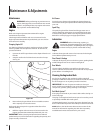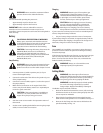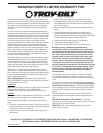
21sectiOn 7 — service 21sectiOn 7 — service
Tires
WARNING! Never exceed the maximum inflation
pressure shown on the sidewall of the tire.
The recommended operating tire pressure is:
Approximately 10 psi for the rear tires
Approximately 14 psi for the front tires
IMPORTANT: Refer to the tire sidewall for exact tire
manufacturer’s recommended or maximum psi. Do not
overinflate. Uneven tire pressure could cause the cutting deck to
mow unevenly.
Battery
CALIFORNIA PROPOSITION 65 WARNING!
Battery posts, terminals, and related accessories
contain lead and lead compounds, chemicals known
to the State of California to cause cancer and
reproductive harm. Wash hands after handling.
CAUTION: If removing the battery, disconnect the
NEGATIVE (Black) wire from it’s terminal first,
followed by the POSITIVE (Red) wire. When re-
installing the battery, always connect the POSITIVE
(Red) wire its terminal first, followed by the
NEGATIVE (Black) wire.
Jump Starting
WARNING! Never jump start a damaged or frozen
battery. Be certain the vehicles do not touch, and
ignitions are off. Do not allow cable clamps to touch.
Connect positive (+) cable to positive post (+) of your
tractor’s discharged battery.
Connect the other end of the cable to the (positive +) post
of the jumper battery.
Connect the second cable (negative –) to the other post of
the jumper battery.
Make the final connection on the engine block of the
tractor, away from the battery. Attach to a unpainted part
to assure a good connection.
CAUTION: If the jumper battery is installed on a
vehicle (i.e. car, truck), do NOT start the vehicle’s
engine when jump starting your tractor.
Start the tractor as instructed in the Operation section of
this manual.
Set the tractor’s parking brake before removing the jumper
cables, in reverse order of connection.
•
•
1.
2.
3.
4.
5.
6.
7.
Charging
WARNING! Batteries give off an explosive gas
while charging. Charge the battery in a well
ventilated area and keep away from an open flame
or pilot light as on a water heater, space heater,
furnace, clothes dryer or other gas appliances.
CAUTION: When charging your tractor’s battery,
use only a charger designed for 12V lead-acid
batteries. Read your battery charger’s Owner’s
Manual prior to charging your tractor’s battery.
Always follow its instructions and heed its warnings.
If your tractor has not been put into use for an extended period
of time, charge the battery as follows:
Set your battery charger to deliver a max of 10 amperes.
If your battery charger is automatic, charge the battery until the
charger indicates that charging is complete. If the charger is not
automatic, charge for no fewer than eight hours.
Fuse
One 20 AMP fuse is installed in your tractor’s wiring harness to
protect the tractor’s electrical system from damage caused by
excessive amperage.
If the electrical system does not function, or your tractor’s engine
will not crank, first check to be certain that the fuse has not
blown. It can be found at the rear of the unit, underneath the
fender located by the battery.
WARNING! Always use a fuse with the same
amperage capacity for replacement.
Cutting Blades
WARNING! Shut the engine off and remove
ignition key before removing the cutting blade(s) for
sharpening or replacement. Protect your hands by
using heavy gloves when grasping the blade.
WARNING! Periodically inspect the blade spindles
for cracks or damage, especially if you strike a
foreign object. Replace immediately if damaged.
The blades may be removed as follows.
Remove the deck from beneath the tractor, (refer to Cutting
Deck Removal earlier in this section) then gently flip the deck
over to expose its underside.
Place a block of wood between the center deck housing
baffle and the cutting blade to act as a stabilizer. See Fig. 7-4.
Remove the hex flange nut that secures the blade to the
spindle assembly. See Fig. 7-4.
1.
1.
2.
3.


















